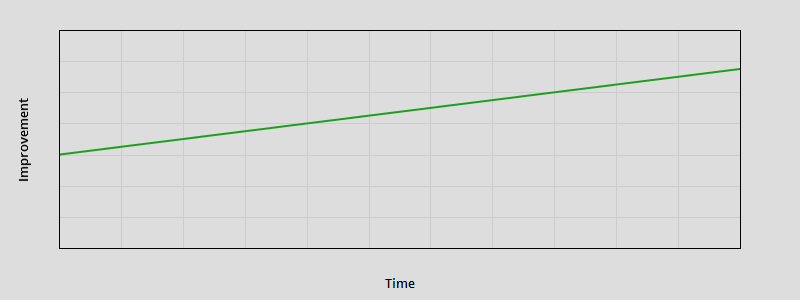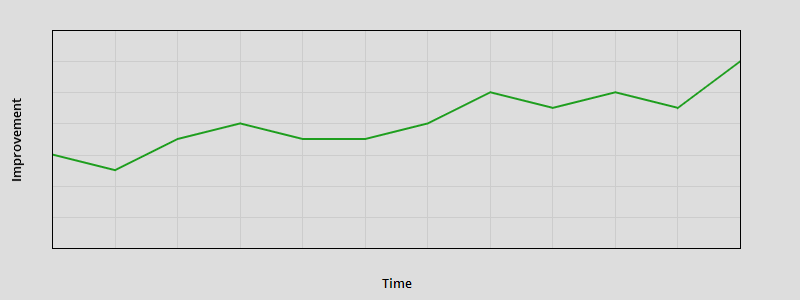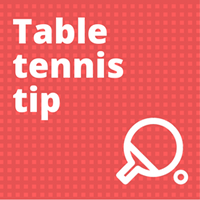We all have periods when we feel our progress has stalled or our form has dipped.
This is entirely normal.
I often remind the players I coach (and myself), that improvement doesn’t take place in a straight line.

In reality improvement often looks like the graph below, with lots of ups and downs, but gradually moving in the right direction.

Let’s look at what can cause a dip in form and what you can do about it.
What causes a dip in form?
There could be a number of reasons why you have a dip in form. Here are some of the most common:
- Not enough practice – you’re not spending enough time on the table hitting balls, so you lose some sharpness
- Aches, pains, strains and injuries – you don’t push yourself as hard as you can to protect your body
- Overtraining – your body is too tired or training is becoming a chore and your motivation drops
- A big change in technique – often when you make a big change to your technique, you get worse before you get better, as it takes time to develop consistency and confidence
- Your mind is elsewhere – work, family, finance, health, relationships
- Overconfidence – you’ve been playing well so start thinking you’re better than you are and become complacent
- Underconfidence – you’ve had a bad performance and start to doubt your table tennis abilities
- Lack of motivation – you have no goals you’re aiming for, so see no purpose in trying to improve
What to do about a dip in form
The most important thing to do when you have a dip in form is don’t panic. As the graphs above show, improvement doesn’t happen in a straight line. It goes up and down.
Dips in form are usually temporary. So don’t compare yourself to how you were playing last week or last month. Instead compare your form over a long time period, e.g. a year ago.
Are you a better player than this time last year? Hopefully, the answer will be yes.
When you have reassured yourself that you are good at table tennis, and your dip in form is temporary, you can plan how to get back to playing your best.
Take a break
Sometimes the best answer is to take a break. This is certainly true if you have a persistent injury, which is preventing you from playing your best. Rather than struggling through and making the injury worse, it’s best to stop playing and let your body recover.
Other reasons why you may want to take a break is if you’re mind is seriously distracted with life issues or you your motivation level has significantly dropped. Table tennis is just a game. A silly game, when you really think about it. Take a break. Do something else. Come back to playing when you feel refreshed.
Players are sometimes worried that if they stop playing for a week, two weeks or whole month, everyone else is going to get better than them. This doesn’t really seem to happen. Often the opposite is true. Players come back from a break revitalised. The reset button has been pressed. They have renewed energy, focus and appetite for playing. They can very quickly return to playing their best.
Purposeful practise
Taking a break is only the answer in some situations. Most times, when you experience a dip in form, the best answer is to get back to the practice table. This is where improvement takes place.
Part of your focus should be on practising any shots you’re struggling with. For example, if you keep losing points with unforced pushing errors, now is the time is to work on improving the consistency of your pushing. Or if your opponents keep exploiting your weak backhand, now is the time to pay some special attention to improving your backhand, so it becomes less of a weakness. This will give your more confidence when you play your next competitive match.
But it’s not all about focusing on your weaknesses. A good way to recover from a dip in form is to practise your strong shots too. So if you have a strong forehand topspin, do plenty of drills where you use this shot. Focus on making your strength as consistent (and deadly!) as possible. This will put your in a positive mind-frame. Even if you have a few weaknesses in your game (we all do), you can feel reassured that your strong shots are working really well. Another confidence boost.
Whatever you do on the practice table, make sure you practise with a purpose. Really try to analyse your own performance in competitive matches. What are your weaknesses? What are your strengths? Work on both.
Dips in form are temporary
A temporary dip is fine. It happens to us all. The important thing is to recognise you have a dip in form and do something about it. You need to stop a dip in form turning into a long term slump.
Take a break if you’re injured, unmotivated or your mind is distracted with personal issues. Otherwise get back to the practice table and get your game into tip-top shape with some purposeful practise.
Take your game to the next level
If you are serious about improving your table tennis skills, I recommend you join Tom’s TT Academy. In my online academy, you will get access to a wide range of coaching content, including:
- in-depth courses
- training drills
- video analysis
- fitness videos
- robot training videos
- member discussions
- skill challenges
- and lot’s more!
You can access all this content for less than £1 per week. New content is added regularly. Join hundreds of table tennis players around the world today at tomsttacademy.com

